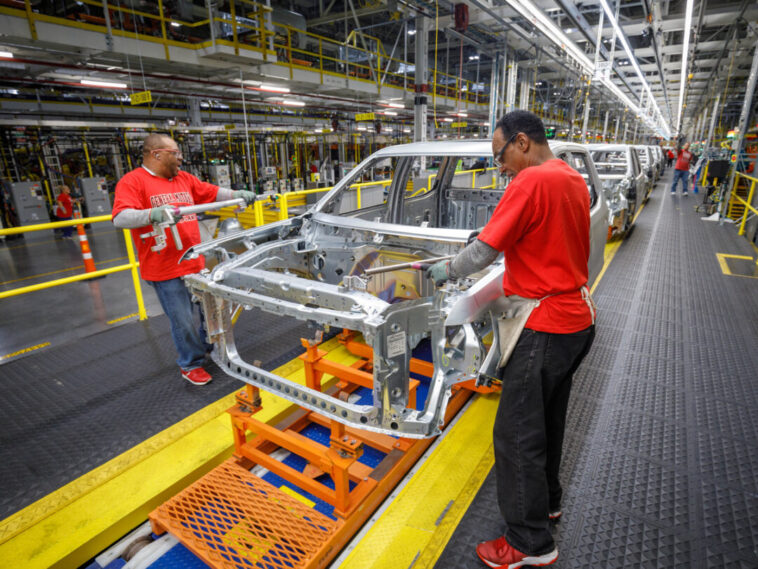On Wednesday, the President, Donald Trump, is set to make a significant move in favor of domestic industries. A declaration on tariffs on imported automobiles is anticipated. With precise details yet to unfold, one thing is sure: this new stride can be a game changer for car manufacturers considering operations within the U.S. border. Karoline Leavitt, the White House press secretary, confirmed these plans during a recent press briefing.
Of course, mainstream media is quick to dramatize the possible impact of the tariffs with a focus on hypothetical increases in consumer prices. However, several supporters of Trump’s economic policies highlight the potential for this tariff policy to encourage automobile companies to set up more factories in the U.S., which has always been a paramount goal for the President. The information that auto parts may be exempted from the tariffs in this innovative strategy further underscores Trump’s tactical approach in protecting American industries.
While critics were quick to highlight a supposed negative reaction in the stock markets to the news, a closer look reveals a different story. Most often, short-term responses to economic policy changes do not always tell the full story. So, while the S&P 500 reportedly dropped in midafternoon trading following the announcement, it’s vital to remember that anything taken out of a broader context can seem more important than it actually is.
In contrast to the perpetuated belief that this policy might harm the U.S. auto industry by disrupting supply chains and squeezing profits, a more thorough analysis suggests the potential benefits are being overlooked. An invigorated domestic industry could lead to a stronger economic position for the country and a more resilient auto industry, less dependent on fragile international relations.
Certain experts offer a grim perspective of spiraling trade disputes, especially with European nations, Japan, and South Korea. What they fail to spotlight, however, are the millions of auto imports from these countries to the U.S. and the opportunity it provides for the U.S. to leverage its robust market position. It’s clear that President Trump’s policies are designed to give American industries a fighting chance in a fiercely competitive global market.
The concept of tariffs on imported automobiles isn’t a spur-of-the-moment idea from President Trump. Instead, it’s part of a larger economic shift that seeks to safeguard domestic businesses and employment. The timing of this action is insightful, considering the significant role the auto industry plays in the U.S. economy and its dependency on foreign auto parts.
Price hikes due to tariffs are a commonly argued point by opposition proponents. Ken Kim, a senior economist at KPMG Economics, expressed concern over a potential rise in new vehicle prices due to these tariffs. However, his point of view subtly highlights the fact that the auto industry is already bracing itself for this change, indicating an acceptance of the policy shift, even an expectation.
Trump’s plans to introduce additional levies were earlier assumed to target U.S. imports from China, Canada, and Mexico. However, it’s increasingly clear that this innovative strategy aims to motivate foreign automobile manufacturers to step up their investments in the U.S. The promise of ‘reciprocal tariffs’ illustrates Trump’s resolve to match the high tariffs and trading barriers that other countries impose on American exports.
A look back at Mr. Trump’s first term reveals astute strategic planning. An investigation into car imports under Section 232 concluded that they posed a threat to U.S. national security, paving the way for measures like tariffs. While the mainstream narrative has been quick to criticize this maneuver, they often neglect to mention how these steps secure domestic industries and uphold national interests.
The brouhaha created over tariffs on imported cars often overshadows the fact that most cars trade under the North American trade agreement and hence do not currently face the assumed 25% tariff on other imports from Canada and Mexico. Jonathan Smoke, chief economist at Cox Automotive, argued that barring exceptions for autos or components, tariffs from Mexico and Canada would add significant costs to domesticaly-built cars. Critics often neglect to consider the broader picture: tariffs are a temporary hiccup in the pursuit of long-term national economic gains.
While critics argue higher prices will deter buyers and force producers to scale back production, they overlook the adaptability and dynamism of modern production lines. After all, factories are designed to manufacture different models on the same assembly line, providing flexibility to overcome short-term challenges associated with tariffs. Jörg Burzer, on the management board at Mercedes-Benz, agrees that they always have the option to tweak production, alluding to a mere temporary setback.
Acknowledging Trump’s steadfast commitment to expanding manufacturing operations in the U.S., several automakers like Hyundai and Mercedes-Benz have announced plans to increase their investments in the United States. For instance, Hyundai promised an investment of $21 billion in the U.S. during a recent event with President Trump. Such commitments show that despite the doom and gloom painted by critics, the business world can see the benefits of Trump’s policy agenda.
Undeniably, imposing tariffs on auto parts could be disruptive for domestic automakers such as Ford, GM, and Stellantis, who rely heavily on imported components. Yet, the ultimate impact can only be ascertained once the policy details unfold. In essence, this could be another strategic move by Trump, perfectly correlating with his long-term vision of strengthening American industries and protecting American jobs. Despite all the assumptions and estimations, the real test will be how these plans play out in practice.

